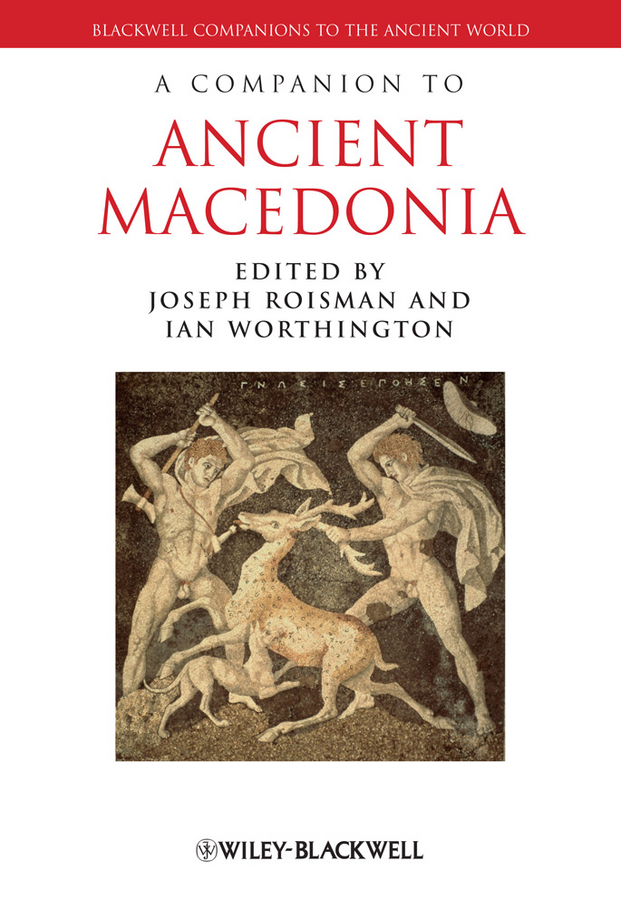


Contents
List of Illustrations
Maps
Figures
Plates
List of Contributors
Preface
Notes on Style
List of Abbreviations
Frequently Cited Ancient Authors
Frequently Cited Modern Collections of Ancient Literary and Epigraphical Material
Frequently Cited Modern Works
Maps
PART I Preamble
1 Why Study Ancient Macedonia and What this Companion is About
PART II Evidence
2 The Literary and Epigraphic Evidence to the Roman Conquest
1 Introduction
2 Literary Evidence
3 Epigraphic Evidence
4 Conclusion
3 The Numismatic Evidence1
1 Money Matters
2 The Tribes
3 The Cities
4 The Kings36
5 The Roman Province of Macedonia
6 Case Study − From Coin to History: Rome, Macedonia and Alexander the Great
PART III Macedonia and Macedonians
4 The Physical Kingdom
1 Introduction
2 Creating a Kingdom
3 Rivers
4 Mountains
5 Expansion from the Core
6 Expansion by 336
7 Conclusion
5 Macedonians and Greeks
1 Macedonian Ethnic Identity and Ethnicity
2 Methodological Problems Resulting from Our Sources
3 Makedon as Mythical Ancestor, the Kings, Macedonian Language and Focal Places for all Macedonians
6 Perspectives on the Macedonians from Greece, Rome, and Beyond
1 Introduction
2 Classical and Hellenistic Perceptions of the Kings of Macedonia
3 Greek Perspectives on the Macedonian Soldiery
4 Roman Perspectives on the Macedonians and their Kings
5 Two Eastern Perspectives on the Macedonian Victors: Persian and Egyptian
6 Conclusion
PART IV History
7 The Early Temenid Kings to Alexander I
1 Perdiccas and the Dynastic Tradition of the Temenidae
2 Formation of the Early Macedonian State
3 Amyntas I and the Coming of the Persians
4 Alexander I in the Time of Xerxes’ Invasion of Greece
5 The Aftermath of Persian Withdrawal
6 Alexander I and the Greeks
7 Final Remarks
8 Classical Macedonia to Perdiccas III
1 Introduction
2 Perdiccas II
3 From Archelaus to Amyntas III
4 Amyntas III
5 From Alexander II to Perdiccas III
6 Review
9 Philip II
1 The Early Years of Philip’s Reign
2 Philip’s Expansion and Athens’ Reaction
3 The End of the Third Sacred War, the Peace of Philocrates and the Way to Chaeronea
4 The League of Corinth and Philip’s Persian Plans
5 Philip’s Last Years and End
6 Philip’s Impact on Macedonia
10 Alexander the Great, Macedonia and Asia
1 Youth and Upbringing
2 Early Kingship
3 Alexander in Asia
4 Macedonia in Alexander’s Absence
5 The Lamian War
6 Conclusion
11 Alexander’s Successors to 221 BC
1 Introduction
2 In the Wake of Alexander (323–319)
3 The Struggle for Macedonia (319–316)
4 Cassander’s Regency (316–310)
5 The Final Struggle (310–298)
6 Demetrius I Poliorcetes and Limbo (298–277)
7 Antigonus II Gonatas (277–239)
8 Demetrius II (239–229)
9 Philip V and Antigonus III Doson (229–221)
12 Macedonia and Rome, 221–146 BC
1 Introduction
2 Sources
3 Rome, Macedonia, and Illyria (230–217)
4 The First War Between Rome and Macedonia
5 The Crisis in the Greek State– System and the Second War between Rome and Macedonia
6 The Recovery of Macedonia and the Third Macedonian War
7 The End of Macedonian Freedom
8 Conclusion
13 Provincia Macedonia
1 Introduction
2 Sources
3 The Creation of the Province
4 The Province in the Republican Period
5 The Via Egnatia
6 Macedonia during the Civil Wars
7 Macedonia in the Imperial Period
8 Conclusion
PART V Neighbours
14 Macedonia, Illyria and Epirus
1 Introduction
2 Early Contacts
3 Contacts to Philip II and Alexander the Great
4 Philip II and Alexander the Great
5 After Alexander
6 Perseus, Epirus and Illyria
15 Macedonia and Thessaly
1 Thessalian Topography, Politics and Society
2 Before Philip II
3 Philip II and Alexander the Great
4 After Alexander the Great
5 Beyond Politics
16 Macedonia and Thrace
1 Thrace – A Geographical Expression
2 Macedonians and Thracians: Competitive and Competing Societies
3 Conclusions
17 Macedonia and Persia
1 Persian Rule in Macedonia (about 512/511–479)
2 Macedonia Under Philip II versus Persia under Artaxerxes III Ochus
3 Alexander III and Darius III – The Great War (334–330)
4 Breakthrough Political Reforms in Parthia – Alexander and Iranian Ways (330)
5 Alexander’s Policies vis-à-vis the Iranians in Central Asia (329–327)
6 Macedonian–Iranian Cooperation in the Indian War (327–325): Politics and Propaganda Images
7 The Political Reforms in Persis, Susa and Opis (324)
8 Iranians in Alexander’s Army and City Foundations
9 Between Macedonia and Iran: Alexander and the New Empire
PART VI Politics, Society, Economy and Culture
18 Macedonian Kingship and Other Political Institutions1
1 Constitution versus Autocracy
2 Kingship before Philip II (about 510–359)
3 Institutions under Philip II and Alexander III (359–323)
4 Institutions after Alexander III (323–167)
19 Social Customs and Institutions: Aspects of Macedonian Elite Society
1 Court Symposia6
2 Hunting
3 The Institution of the paides
4 Conclusion
20 Macedonian Women
1 The Argead Era (seventh century to c.316)
2 Royal Women in the Argead Era
3 The Transitional Period (c.316–c.277/6)
4 The Antigonid Era (c.277/6–169/8)
5 The Roman Period
21 Macedonian Religion
1 Deities of Particular Significance to Macedonians
2 Death as a Passage into an Afterlife
3 Openness to Foreign Influences
4 Tombs not Temples
5 Role of the King
6 Divine Rulers
7 Conclusion
22 The Macedonian Army
I MACEDONIAN MILITARY ORGANIZATION
II THE MACEDONIAN SOLDIER
23 The Political Economy of Macedonia
1 The Way Ahead
2 At the Edge of the World?
3 Philip’s Military, Alexander’s Moral Economy
4 Return to the Edge of the World?
24 Classical Art to 221 BC
1 Patronage3
2 The Material: Painting
3 The Material: Metalwork
4 The Material: Other Media
5 Conclusion
25 Hellenistic and Roman Art, 221 BC–AD 337
1 Introduction: Approaches to Macedonian Art under the Roman Empire
2 The End of the Macedonian Monarchy and the Origins of the Provincia Macedonia
3 Macedonian Art in the Roman Empire
4 Macedonia in the Late Empire
PART VII After Rome
26 Macedonia in Late Antiquity
1 Sources
2 Movable Provinces
3 The Enhanced Role of Thessaloniki
4 Political, Military and Economic Developments
5 Christianity in Macedonia
6 Cities, Towns, Villages and Fortifications
7 Conclusion
27 Ancient Macedonia, Alexander the Great and the Star or Sun of Vergina: National Symbols and the Conflict between Greece and the Republic of Macedonia
1 The Macedonian Question: An Overview
2 The Construction of National Identities, Cultures and Histories
3 Ancient Macedonia
4 Alexander the Great
5 The Star or Sun of Vergina
6 The First International Congress on Macedonian Studies
7 International Recognition of the Republic of Macedonia
8 The Macedonian Minority of Northern Greece
9 Conclusion
Bibliography
ins
Index
BLACKWELL COMPANIONS TO THE ANCIENT WORLD
This series provides sophisticated and authoritative overviews of periods of ancient history, genres of classical literature, and the most important themes in ancient culture. Each volume comprises between twentyfive and forty concise essays written by individual scholars within their area of specialization. The essays are written in a clear, provocative, and lively manner, designed for an international audience of scholars, students, and general readers.
ANCIENT HISTORY
Published
A Companion to the Roman Army
Edited by Paul Erdkamp
A Companion to the Roman Republic
Edited by Nathan Rosenstein and Robert Morstein-Marx
A Companion to the Roman Empire
Edited by David S. Potter
A Companion to the Classical Greek World
Edited by Konrad H. Kinzl
A Companion to the Ancient Near East
Edited by Daniel C. Snell
A Companion to the Hellenistic World
Edited by Andrew Erskine
A Companion to Late Antiquity
Edited by Philip Rousseau
A Companion to Ancient History
Edited by Andrew Erskine
A Companion to Archaic Greece
Edited by Kurt A. Raaflaub and Hans van Wees
A Companion to Julius Caesar
Edited by Miriam Griffin
A Companion to Byzantium
Edited by Liz James
A Companion to Ancient Egypt
Edited by Alan B. Lloyd
A Companion to Ancient Macedonia
Edited by Joseph Roisman and Ian Worthington
In preparation
A Companion to the Punic Wars
Edited by Dexter Hoyos
A Companion to Sparta
Edited by Anton Powell
LITERATURE AND CULTURE
Published
A Companion to Classical Receptions
Edited by Lorna Hardwick and Christopher Stray
A Companion to Greek and Roman Historiography
Edited by John Marincola
A Companion to Catullus
Edited by Marilyn B. Skinner
A Companion to Roman Religion
Edited by Jörg Rüpke
A Companion to Greek Religion
Edited by Daniel Ogden
A Companion to the Classical Tradition
Edited by Craig W. Kallendorf
A Companion to Roman Rhetoric
Edited by William Dominik and Jon Hall
A Companion to Greek Rhetoric
Edited by Ian Worthington
A Companion to Ancient Epic
Edited by John Miles Foley
A Companion to Greek Tragedy
Edited by Justina Gregory
A Companion to Latin Literature
Edited by Stephen Harrison
A Companion to Greek and Roman Political Thought
Edited by Ryan K. Balot
A Companion to Ovid
Edited by Peter E. Knox
A Companion to the Ancient Greek Language
Edited by Egbert Bakker
A Companion to Hellenistic Literature
Edited by Martine Cuypers and James J. Clauss
A Companion to Vergil’s Aeneid and its Tradition
Edited by Joseph Farrell and Michael C. J. Putnam
A Companion to Horace
Edited by Gregson Davis
In preparation
A Companion to the Latin Language
Edited by James Clackson
A Companion to Greek Mythology
Edited by Ken Dowden and Niall Livingstone
A Companion to Sophocles
Edited by Kirk Ormand
A Companion to Aeschylus
Edited by Peter Burian
A Companion to Greek Art
Edited by Tyler Jo Smith and Dimitris Plantzos
A Companion to Families in the Greek and Roman World
Edited by Beryl Rawson
A Companion to Tacitus
Edited by Victoria Pagán
A Companion to the Archaeology of the Ancient Near East
Edited by Daniel Potts

This edition first published 2010
© 2010 Blackwell Publishing Ltd
Blackwell Publishing was acquired by John Wiley & Sons in February 2007. Blackwell’s publishing program has been merged with Wiley’s global Scientific, Technical, and Medical business to form WileyBlackwell.
Registered Office
John Wiley & Sons Ltd, The Atrium, Southern Gate, Chichester, West Sussex, PO19 8SQ, United Kingdom
Editorial Offices
350 Main Street, Malden, MA 02148–5020, USA
9600 Garsington Road, Oxford, OX4 2DQ, UK
The Atrium, Southern Gate, Chichester, West Sussex, PO19 8SQ, UK
For details of our global editorial offices, for customer services, and for information about how to apply for permission to reuse the copyright material in this book please see our website at www.wiley.com/wileyblackwell.
The right of Joseph Roisman and Ian Worthington to be identified as the author of the editorial material in this work has been asserted in accordance with the UK Copyright, Designs and Patents Act 1988.
All rights reserved. No part of this publication may be reproduced, stored in a retrieval system, or transmitted, in any form or by any means, electronic, mechanical, photocopying, recording or otherwise, except as permitted by the UK Copyright, Designs and Patents Act 1988, without the prior permission of the publisher.
Wiley also publishes its books in a variety of electronic formats. Some content that appears in print may not be available in electronic books.
Designations used by companies to distinguish their products are often claimed as trademarks. All brand names and product names used in this book are trade names, service marks, trademarks or registered trademarks of their respective owners. The publisher is not associated with any product or vendor mentioned in this book. This publication is designed to provide accurate and authoritative information in regard to the subject matter covered. It is sold on the understanding that the publisher is not engaged in rendering professional services. If professional advice or other expert assistance is required, the services of a competent professional should be sought.
Library of Congress Cataloging-in-Publication Data is available for this title
ISBN 978-1-4051-7936-2 (hardcover : alk. paper)
Illustrations
Maps
1 Mainland Greece
Adapted from map 2 in R.M. Errington, A History of the Hellenistic World: 323–30 BC (Wiley-Blackwell 2008), pp. xvi-xvii
2 Regions of Macedonia
Created for C.G. Thomas by Lance Jenott and altered by Jason Shattuck
3 Expansion of Macedonia
Created for C.G. Thomas by Lance Jenott and altered by Jason Shattuck
4 Alexander the Great’s Conquests
Taken from W. Heckel and L.A. Tritle, Alexander the Great: A New History (Wiley-Blackwell 2009), pp. xx-xxi
5 Roman Macedonia and the Neighbouring Provinces
Created by J. Vanderspoel
6 Macedonia, Illyria and Epirus
Created for W.S. Greenwalt by Elwood Mills
7 Macedonia and Thessaly
Reproduced with the permission of Yale University Press
8 Macedonia and Thrace
Copyright Z.H. Archibald
9 Macedonia in Late Antiquity
Created by C.S. Snively
10 A map of Macedonia that appeared in the New York Times on February 4, 1993, illustrating the portrayal of the existence of two Macedonias
Figures
8.1 Macedonian royal family tree 454–336 BC (Roisman)
21.1 Drawing of the Lead Curse Tablet from Pella (Christesen and Murray) Reproduced with the permission of Emmanuel Voutiras
24.1 Reconstruction drawing of the Philippeum at Olympia (Hardiman) Reproduced with the permission of David Boggs
25.1 Reconstruction drawing of monument of Aemilius Paullus, about 167 BC (Kousser)
Plates
(between pages 356 and 357)
1 Alexander I, octodrachm, 29.06 g, 31 mm, about 475 BC, Berlin 18200785
Reproduced with the permission of the Münzkabinett, Staatliche Museen zu Berlin
2 Argilus, tetradrachm, 13.92 g, 27 mm, about 490/80 BC, Berlin 18200925
Reproduced with the permission of the Münzkabinett, Staatliche Museen zu Berlin
3 Chalcidic League, tetradrachm, 14.43 g, 25 mm, 9 h, about 390/80 BC, Berlin 18216681
Reproduced with the permission of the Münzkabinett, Staatliche Museen zu Berlin
4 Amphipolis, tetradrachm, 14.52 g, 26 mm, 6 h, about 370/60 BC, Berlin 18215936
Reproduced with the permission of the Münzkabinett, Staatliche Museen zu Berlin
5 Philip II, tetradrachm, Amphipolis mint, 14.29 g, 24 mm, 7 h, about 355–349/48 BC, Berlin 18201161
Reproduced with the permission of the Münzkabinett, Staatliche Museen zu Berlin
6 Alexander III, tetradrachm, Amphipolis mint, 17.04 g, 25 mm, 4 h, about 330 BC, Berlin 18204190
Reproduced with the permission of the Münzkabinett, Staatliche Museen zu Berlin
7 Macedonian first meris, tetradrachm, Amphipolis mint, 16.67 g, 31 mm, 12 h, about 158–150 BC, Berlin 18204055
Reproduced with the permission of the Münzkabinett, Staatliche Museen zu Berlin
8 Philippi, bronze coin, 9.99 g, 27 mm, 12 h, about 10 BC–AD 14, Berlin 18215890
Reproduced with the permission of the Münzkabinett, Staatliche Museen zu Berlin
9 Pella, bronze coin, 8.55 g, 25 mm, 12 h, AD 238–244, Berlin 18215892
Reproduced with the permission of the Münzkabinett, Staatliche Museen zu Berlin
10 Macedonian koinon, bronze coin, 10.42 g, 25 mm, 12 h, AD 238–244, Berlin 18214409
Reproduced with the permission of the Münzkabinett, Staatliche Museen zu Berlin
11 The Macedonians/Aesillas the quaestor, tetradrachm, Thessalonike mint, 16.73 g, 32 mm, 12 h, about 90–75 BC, Berlin 18204057
Reproduced with the permission of the Münzkabinett, Staatliche Museen zu Berlin
12 The delta of the Axios
Photo taken for C.G. Thomas by Theo Antikas
13 The Petra Pass
Photo taken for C.G. Thomas by Richard Johnson
14 The Haliacmon
Photo taken for C.G. Thomas by Richard Johnson
15 Left edge of the Lead Curse Tablet from Pella
Reproduced with the permission of Emmanuel Voutiras
16 The facade of the Lefkadia Great Tomb
Reproduced with the permission of the Archaeological Society at Athens
17 Hades Abducting Persephone, painting from Tomb I (Vergina)
Reproduced with the permission of Studio Kontos/Photostock
18 Facade, painting of hunting scene from Tomb II (Vergina)
Reproduced with the permission of Studio Kontos/Photostock
19 The Derveni Krater
Reproduced with the permission of Studio Kontos/Photostock
20 Stag Hunt Mosaic, Pella
Reproduced with the permission of Studio Kontos/Photostock
21 Abduction of Helen Mosaic, Pella
Reproduced with the permission of the Hellenic Republic Ministry of Culture, Archaeological Receipts Fund (TAP Services, Athens)
22 Silver tetradrachm of Philip V, portrait of Philip on the obverse and an archaistic Athena on the reverse, late third century BC
Reproduced with the permission of the American Numismatic Society
23 Gold stater of T. Quinctius Flamininus, portrait of Flamininus on the obverse and a Nike with palm branch on the reverse, about 196 BC
Reproduced with the permission of the Trustees of the British Museum, courtesy Art Resource, NY
24 Relief showing scene of riderless horse from the Battle of Pydna, monument of Aemilius Paullus, Delphi, about 167 BC
Photo courtesy Foto Marburg/Art Resource, NY
25 Grave stele of Onesimus from the outskirts of Thessalonica, late second century AD, Thessaloniki Museum, inv. no. 1524 Photo courtesy Museum of Casts and Archaeological Collection, University of Thessaloniki; photo number AGME 86 by M. Skiadaressis
26 View of Villa of Dionysus, Dium, towards Mount Olympus, about AD 200
Photo taken by R. Kousser
27 Small Arch of Galerius from the Residence of Galerius, Thessalonica, late third century AD, Thessaloniki Museum, inv. no. 2466
Photo courtesy Museum of Casts and Archaeological Collection, University of Thessaloniki; photo number AGME 12 by M. Skiadaressis
28 View of octagonal reception hall in residence of Galerius, Thessalonica, late third century AD
Photo taken by R. Kousser
List of Contributors
Winthrop Lindsay Adams
Professor of History, Department of History, University of Utah, USA
Edward M. Anson
Professor of History, Department of History, University of Arkansas at Little Rock, USA
Zosia Archibald
Lecturer in Classical Archaeology, School of Archaeology, Classics, and Egyptology, University of Liverpool, England
Sulochana R. Asirvatham
Associate Professor of Classics and General Humanities, Department of Classics and General Humanities, Montclair State University, USA
Elizabeth Carney
Professor of History, Department of History, Clemson University, USA
Paul Christesen
Associate Professor of Classics, Department of Classics, Dartmouth College, USA
Karsten Dahmen
Curator at the Münzkabinett der Staatlichen Museen zu Berlin, Germany
Loring M. Danforth
Charles A. Dana Professor of Anthropology, Department of Anthropology, Bates College, USA
Arthur M. Eckstein
Professor of History and Distinguished Scholar-Teacher, Department of History, University of Maryland, USA
Johannes Engels
apl. Professor of Ancient History, Historisches Seminar I, Alte Geschichte, Universität zu Köln, Germany
Dawn L. Gilley
Assistant Professor of Humanities, Department of History, North-West Missouri State University, USA
Denver Graninger
Director and Professor, American Research Center in Sofia, Sofia, Bulgaria
William S. Greenwalt
Professor of Classics, Department of Classics, Santa Clara University, USA
Craig I. Hardiman
Assistant Professor of Classics, Department of Classical Studies, University of Waterloo, Canada
Carol J. King
Assistant Professor of Classics, Sir Wilfred Grenfell College, Canada
Rachel Kousser
Associate Professor of Art, Department of Art, Brooklyn College, CUNY, USA
Paul Millett
Senior Lecturer in Classics and Fellow of Downing College, University of Cambridge, England
Sabine Müller
Lecturer in Ancient History, Historisches Seminar, Universität Kiel, Kiel, Germany
Sarah C. Murray
PhD student in Classics, Department of Classics, Stanford University, USA
Marek Jan Olbrycht
Head, Department of Ancient History and Oriental Studies, University of Rzeszow, Poland
P.J. Rhodes
Honorary Professor of Ancient History, Department of Classics, University of Durham, England
Joseph Roisman
Professor of Classics, Department of Classics, Colby College, USA
Noriko Sawada
Associate Professor of History, Faculty of Humanities and Social Sciences, Shizuoka University, Japan
Nicholas Victor Sekunda
University Professor, Institute of Archaeology, Gdansk University, Poland
Carolyn S. Snively
Professor of Classics, Department of Classics, Gettysburg College, USA
Sławomir Sprawski
Assistant Professor of History, Department of Ancient History, Jagiellonian University, Krakow, Poland
Carol G. Thomas
Vidalakis Professor of Hellenic Studies, Department of History, University of Washington, USA
John Vanderspoel
Professor of Roman History, Department of Greek and Roman Studies, University of Calgary, Canada
Ian Worthington
Professor of History, Department of History, University of Missouri, USA
Preface
The aim of the Blackwell Companions to the Ancient World series is to ‘provide an international audience of students, scholars, and general readers with sophisticated, one-volume companions to classical and near eastern civilizations, classical literature, and ancient history. The chapters in each volume are to be written primarily for those approaching the topic for the first time (be they undergraduates, graduates, or members of the public) and for scholars operating in adjacent fields of study.’ At the same time those working in the particular field should also find the chapters stimulating.
The present volume (the first companion on ancient Macedonia) presents a series of specially commissioned, original chapters by specialists that cover the range and nature of the source material we have for ancient Macedonia, its political and military history from early times (the first of the Temenid kings) to the end of Roman rule, as well as its geography, relations with its diverse neighbours, social customs, political institutions, economic matters, artistic and intellectual life and achievements, and how the Macedonians were viewed by other civilizations in antiquity. The concluding part of the volume traces the history of Macedonia in late antiquity to the Slavs and the role of Macedonia today in modern Balkan politics. Each chapter has a bibliographical essay that is a guide to further reading and all quotations from ancient sources are translated into English. An introductory chapter (1) discusses the state of Macedonian studies and summarizes the chapters in this volume. We believe that we have covered as much as humanly can be within one set of covers and that the book, written for the primary audience of the companion series, will also be beneficial to specialists in the field.
The chapters intentionally treat the various topics and history of ancient Macedonia both chronologically and thematically. Hence some chapters are longer than others because of the time span that they cover. In any collaborative project, some overlap of material is unavoidable, and this volume is no different. In addition, there is no consensus of opinion on a variety of issues that affect ancient Macedonia, ranging from establishing the historicity of events to the ethnicity of its people, the nature of its political system, and even the role that Macedonian identity played and plays in ancient and modern times. However, both reiteration and especially plurality of interpretations can enhance our understanding and appreciation of a kingdom that seemed to live in the shadow of the Greeks yet would become one of the superpowers of the ancient world. With that said, the responsibility for facts, findings, interpretations, conclusions and opinions expressed in this volume rests exclusively with the contributors. They do not necessarily represent or reflect the views of the other contributors or of the editors.
We have a number of people to thank, in particular Al Bertrand at Blackwell, who responded enthusiastically to Ian Worthington’s idea for this book, and Galen Smith at Blackwell who was always quick to respond to our many enquiries and provided much valuable help and support throughout the editing process. We would also like to thank the contributors who produced excellent work and patiently responded to our comments and suggestions far more diplomatically at times than we expected.
Joseph Roisman would like to thank Ian Worthington, the originator of this book, for his generous offer to join him as coeditor. The project would not have been completed without his industry and sharing of his knowledge. Roisman owes a special thanks to his wife Hanna and his children, Elad and Shalev, for giving so much meaning to his life.
Ian Worthington owes a debt of gratitude to Joseph Roisman who came on board as co-editor and will never forgive him for that, but whose expertise and sensible judgement on so many occasions were greatly appreciated. Worthington also thanks Dawn Gilley, for co-writing his chapter with him, and Josh Nudell for help in compiling the bibliography. And last but not least Worthington’s family deserves special praise for still letting him live under the same roof as them.
Joseph Roisman
Ian Worthington
Notes on Style
Throughout this book, Macedonia/Macedonians refer to the area of the mainland north of Mount Olympus and Greece/Greeks to the area of the mainland south of Mount Olympus.
Greek names are anglicized, but some names and technical terms are transliterated, and these will be obvious when they appear.
References in the text and notes to a scholar’s name followed by a chapter number (for example, J. Roisman, chapter 8) refer to the contributor’s chapter in this book.
As the contributors are based in several different countries, including North American, Europe and Japan, we have allowed American and UK spellings.
All dates and references to centuries are Bc except where indicated.
Abbreviations
Names of journals are abbreviated as in L’Année philologique (less well-known ones are given in full), although consistent with English practice the ‘h’ is dropped in acronyms (thus, CP not CPh).
The following abbreviations are used in this book:
Frequently Cited Ancient Authors
| Ael. | Aelian |
| Aes. | Aeschines |
| Arist. | Aristotle |
| Arr. | Arrian, Anabasis Alexandri |
| Athen. | Athenaeus |
| Curt. | Curtius |
| Dem. | Demosthenes |
| Diod. | Diodorus Siculus |
| Din. | Dinarchus |
| Hdt. | Herodotus |
| Hyp. | Hyperides |
| Isoc. | Isocrates |
| Paus. | Pausanias |
| Pl. | Plato |
| Plut. | Plutarch |
| Polyb. | Polybius |
| Thuc. | Thucydides |
| Xen. | Xenophon |
[] around a name denotes the work is spurious but attributed to that author
Frequently Cited Modern Collections of Ancient Literary and Epigraphical Material
| BNJ | Brill’s New Jacoby, editor-in-chief Ian Worthington (Leiden 2007–) |
| FGrH | F. Jacoby, Die Fragmente der grieschischen Historiker 1–3 (Berlin 1926–59) |
| IG | Inscriptiones Graecae |
| Rhodes and | P.J. Rhodes and R. Osborne, Greek Historical Inscriptions, |
| Osborne | 404–323 Bc (Oxford 2003) |
| SEG | Supplementum Epigraphicum Graecum |
| SIG3 | Sylloge Inscriptionum Graecarum et Latinarum Macedoniae3 (Chicago 1980) |
Frequently Cited Modern Works
| Borza, Shadow of Olympus | E.N. Borza, In the Shadow of Olympus: The Emergence of Macedon (Princeton 1990) |
| Errington, History of Macedonia | R.M. Errington, A History of Macedonia, trans. C. Errington (Berkeley and Los Angeles 1990) |
| Hammond, History of Macedonia 1 | N.G.L. Hammond, A History of Macedonia 1 (Oxford 1972) |
| Hammond and Griffith, History of Macedonia 2 | N.G.L. Hammond and G.T. Griffith, A History of Macedonia 2 (Oxford 1979) |
| Hammond and Walbank, History of Macedonia 3 | N.G.L. Hammond and F.W. Walbank, A History of Macedonia 3 (Oxford 1988) |
| Hammond, Macedonian State | N.G.L. Hammond, The Macedonian State: The Origins, Institutions and History (Oxford 1992) |
| CAH2 | Cambridge Ancient History2 (multi-volume edited by various editors) |
| PSI | Papiri Greci e Latini (Firenze 1912–79) |
Maps
Map 1 Mainland Greece
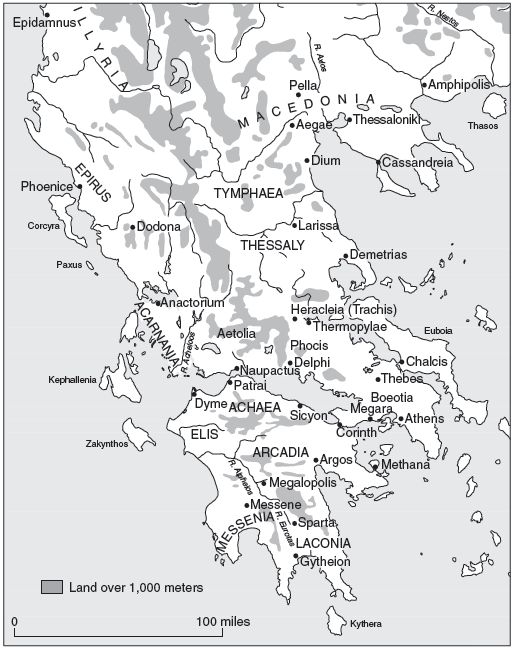
Map 2 Regions of Macedonia

Map 3 Expansion of Macedonia

Map 4 Alexander the Great’s Conquests
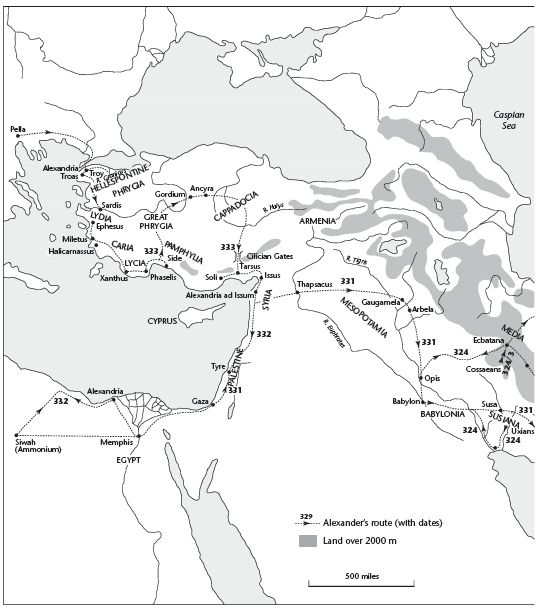
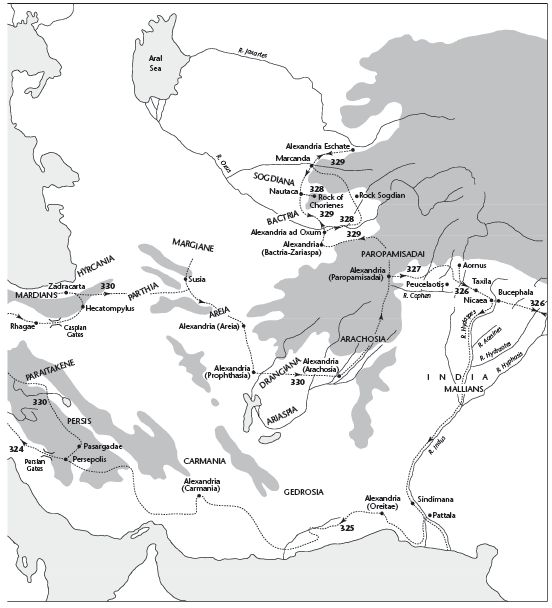
Map 5 Roman Macedonia and the Neighbouring Provinces

Map 6 Macedonia, Illyria and Epirus

Map 7 Macedonia and Thessaly

Map 8 Macedonia and Thrace

Map 9 Macedonia in Late Antiquity

Map 10 A map of Macedonia that appeared in the New York Times on February 4, 1993, illustrating the portrayal of the existence of two Macedonias
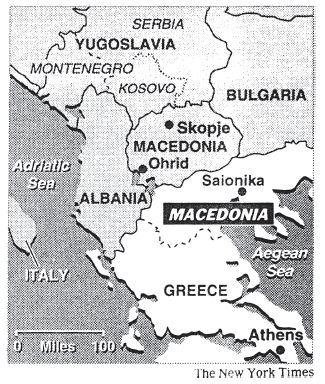
PART I
Preamble